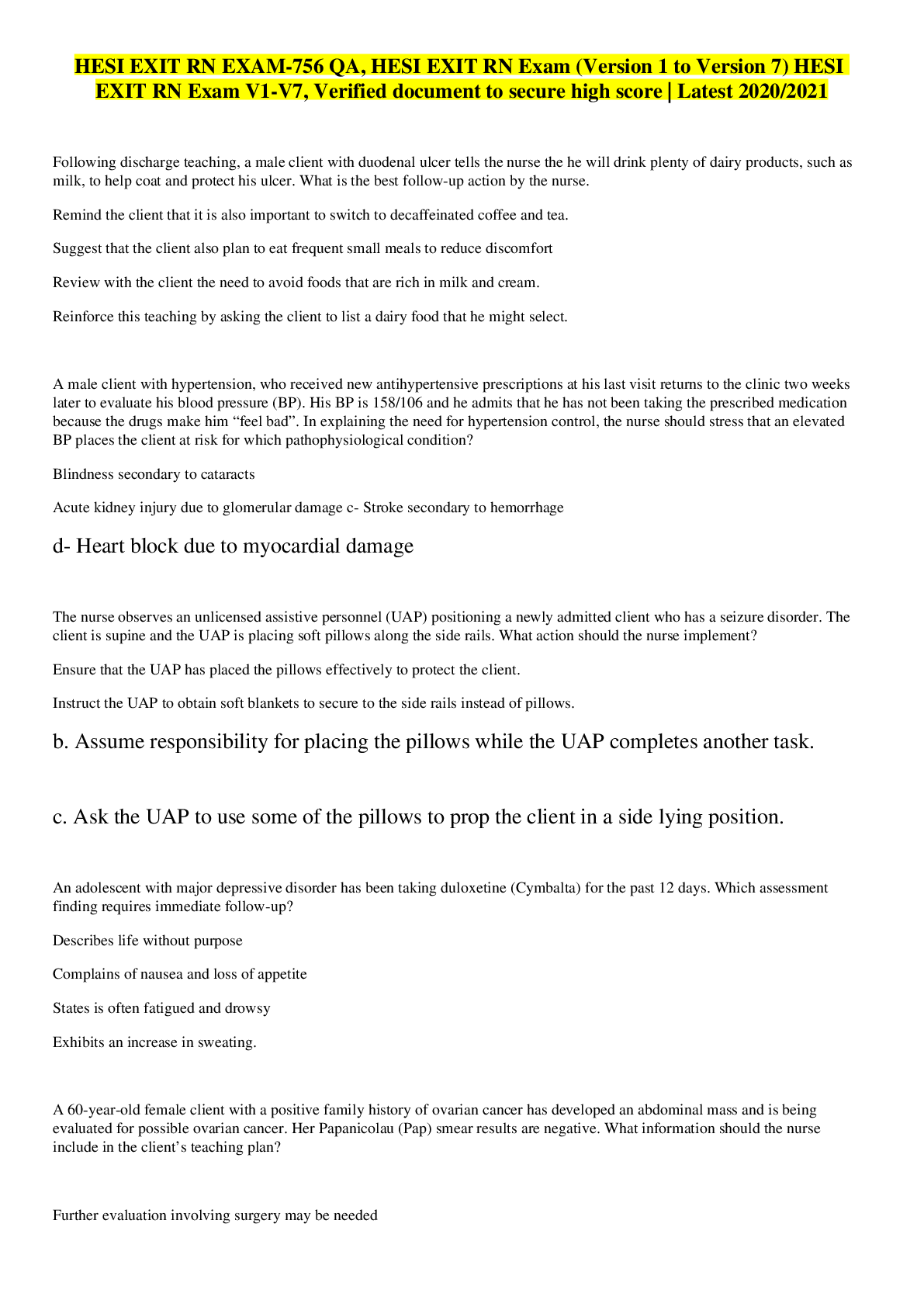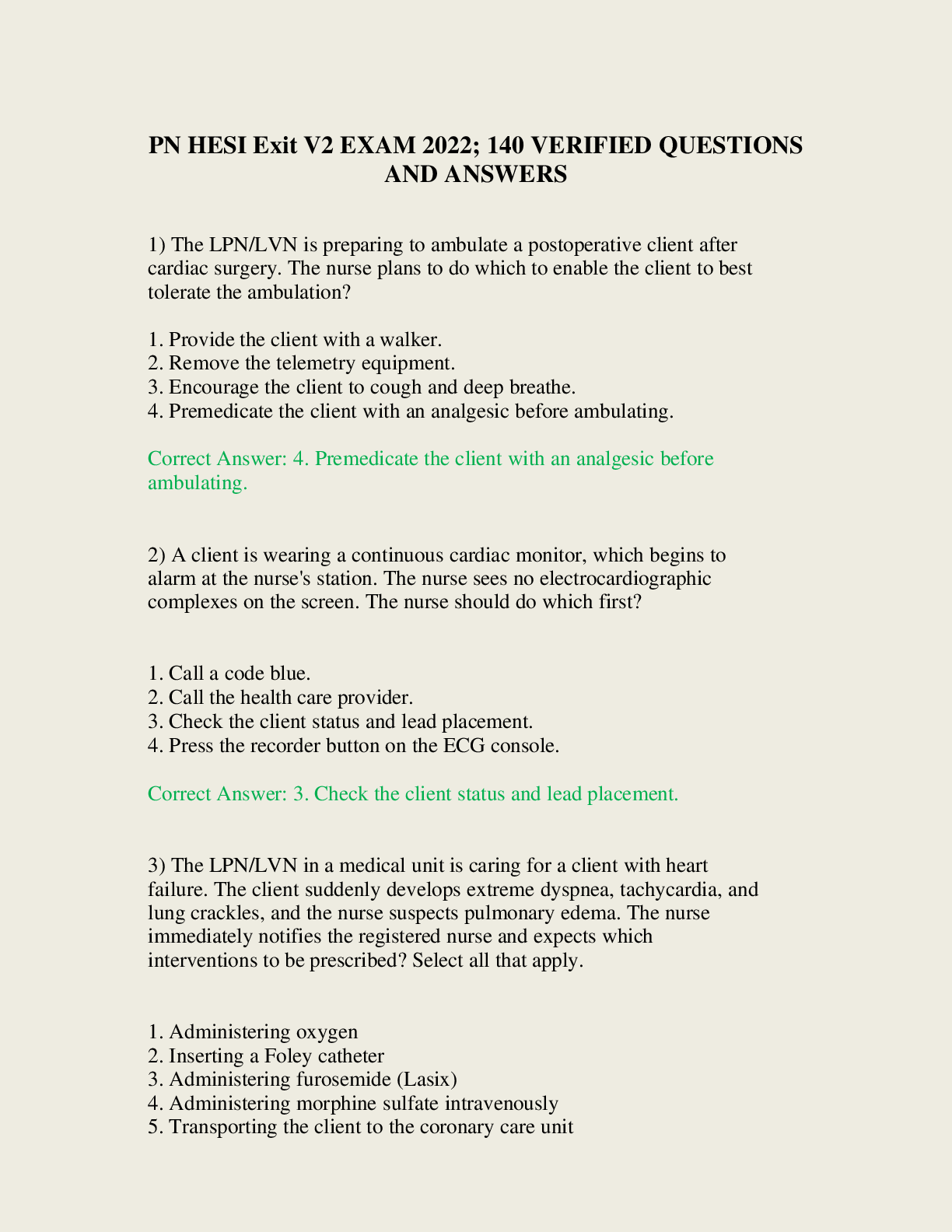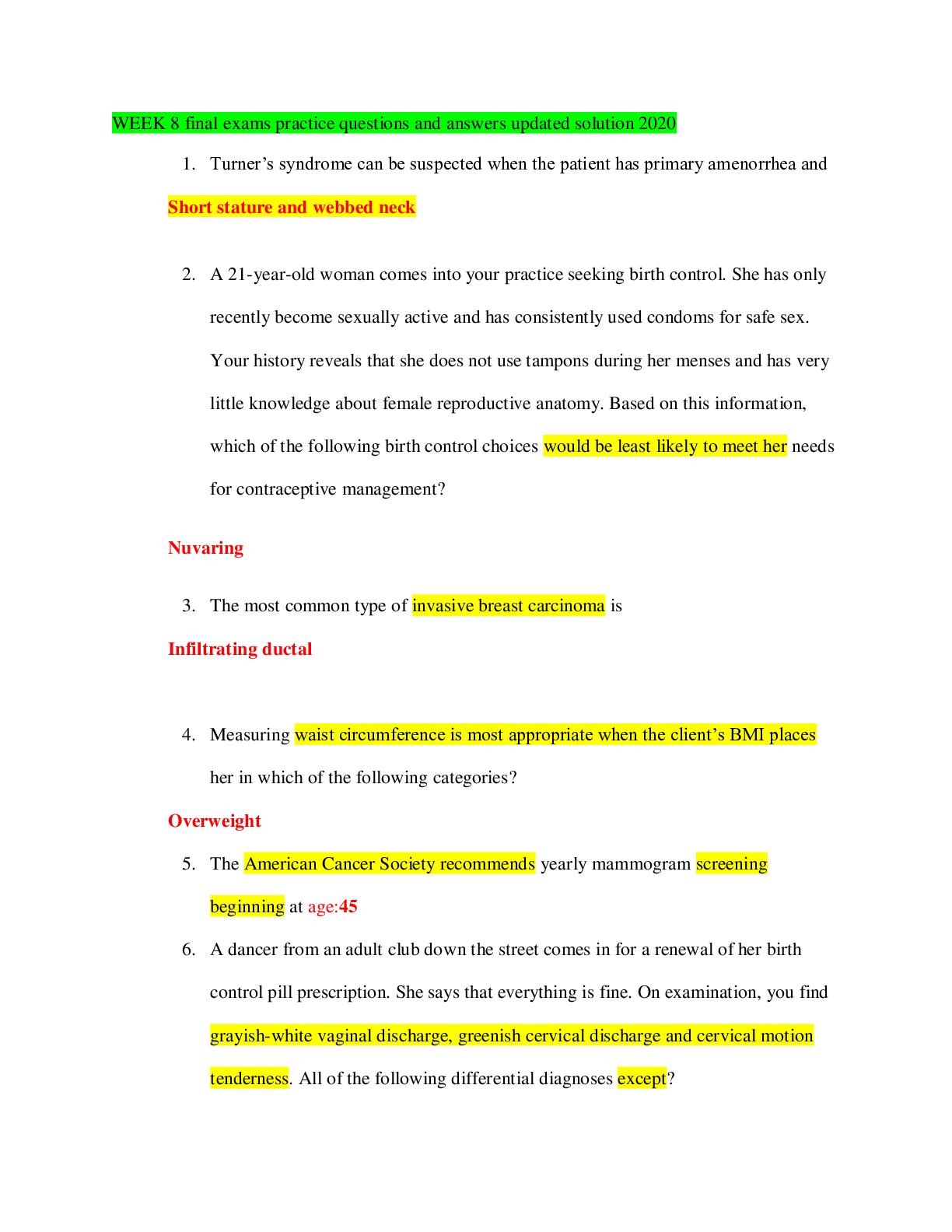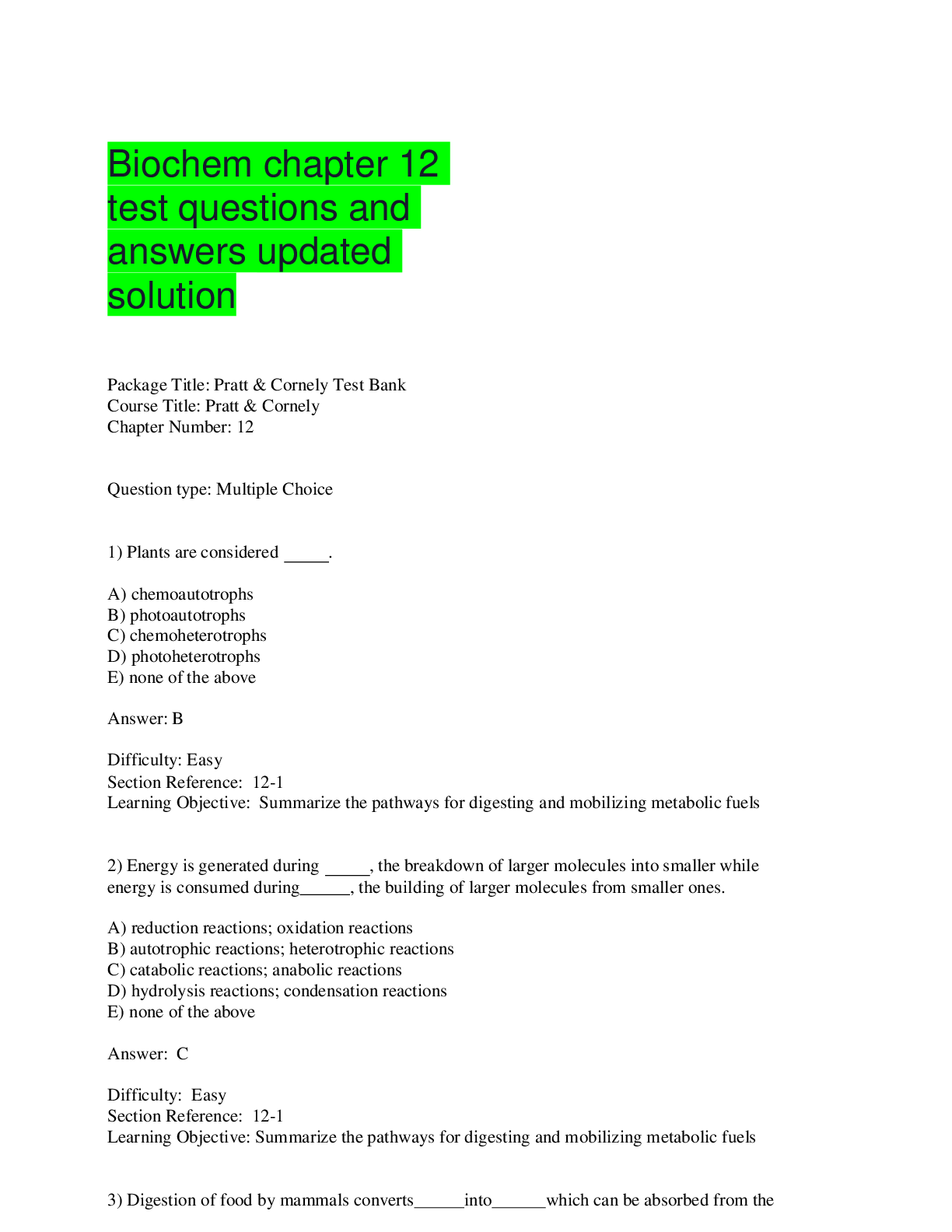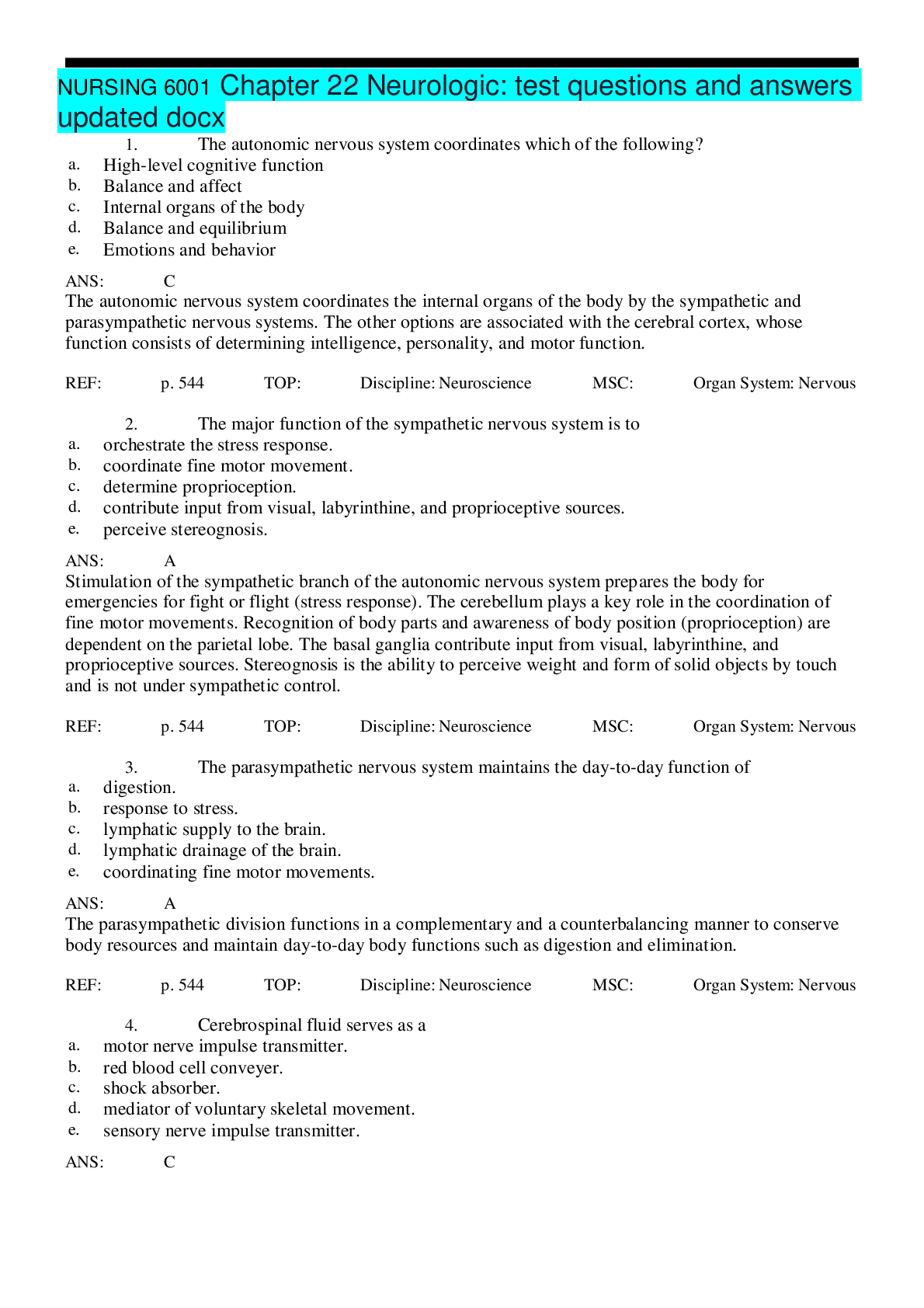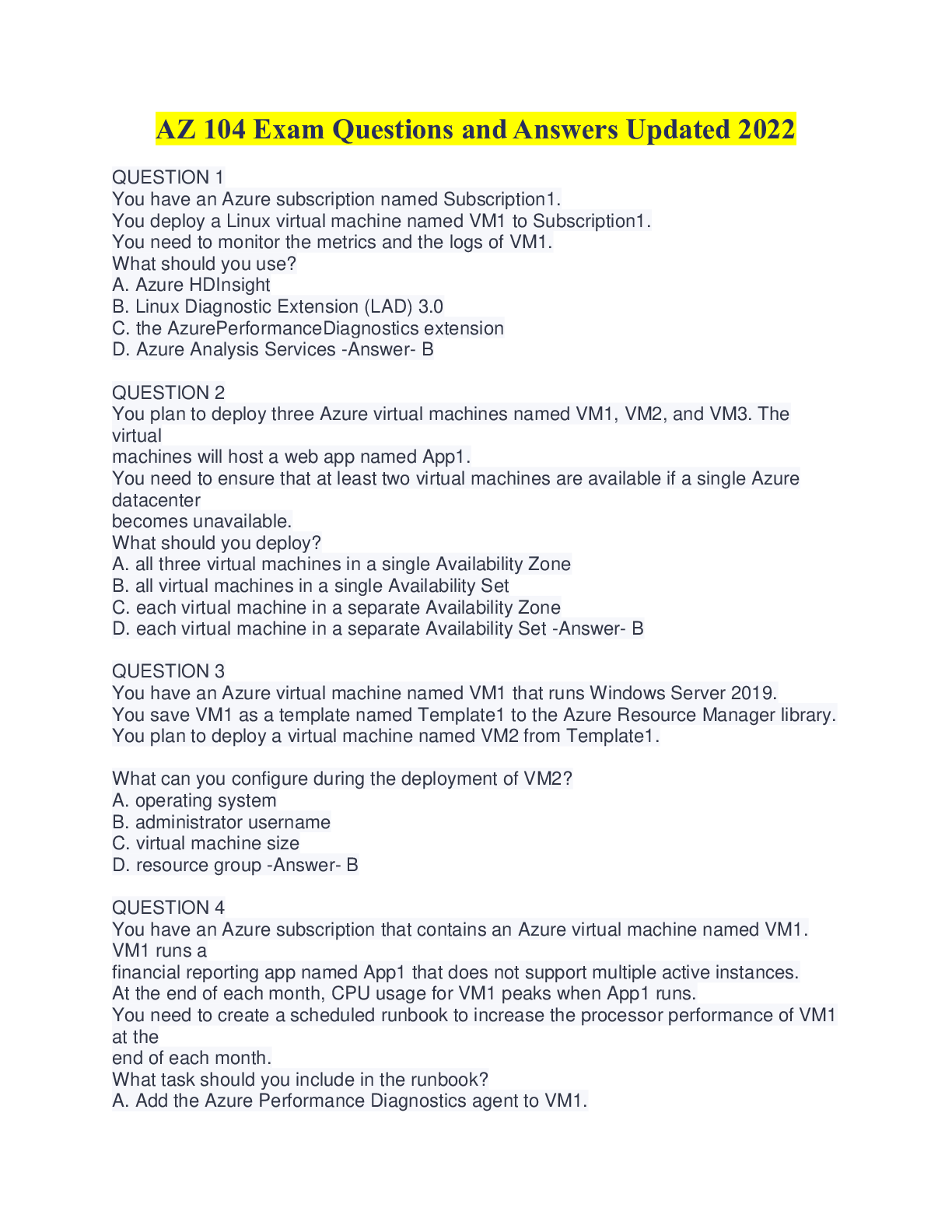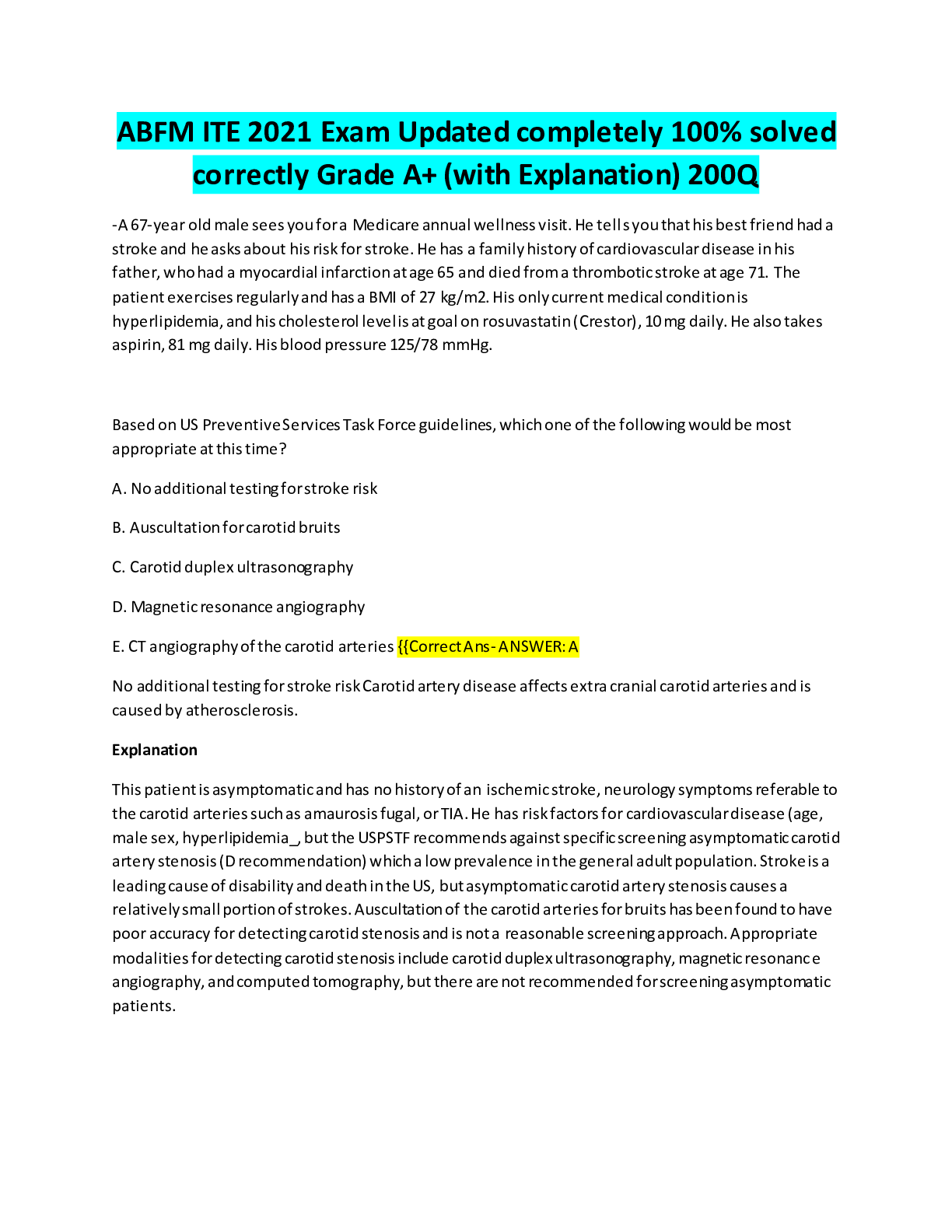*NURSING > QUESTIONS & ANSWERS > ACSM CPT prepU EXAM QUESTIONS AND ANSWERS UPDATED ON 8TH AUGUST 2022 (All)
ACSM CPT prepU EXAM QUESTIONS AND ANSWERS UPDATED ON 8TH AUGUST 2022
Document Content and Description Below
ACSM CPT prepU EXAM QUESTIONS AND ANSWERS UPDATED ON 8TH AUGUST 2022 Which of the following forms may be used if a Health/Medical History Evaluation form is not readily available? a) Personal-Trai... ner Client Agreement b) PAR-Q c) Informed Consent d) Health Fitness Assessment -Answer- b Which of the following statements is the MOST accurate regarding strength training in the lumbo-pelvic region? a) Supine double leg raises should be avoided, but prone double leg raises are beneficial for clients who have low-back pain. b) Full ROM spinal movements with an external load are best performed shortly after rising from bed. c) Pelvic stabilization forces the lumbar muscles to be the primary trunk extensors, thereby providing the overload stimulus for strengthening. d) Low-back exercises have the most beneficial effect when in the transverse plane. - Answer- c Movement resulting in an increase of the joint angle, usually moving posteriorly in the sagittal plane is called __________. a) Rotation b) Extension c) Abduction d) Flexion -Answer- b Scoliosis is defined as: a) Posterior deviation of the spine. b) Medial deviation of the spine. c) A combination of kyphosis and lordosis. d) Lateral deviation of the spine. -Answer- d For men, a 3-site skinfold assessment is taken on the ________ side of the body at the ________. a) Left; triceps, suprailium, and thigh b) Left; chest, abdomen, and thigh c) Right; chest, abdomen, and thigh d) Right; triceps, suprailium, and thigh -Answer- cThe most common manifestation of muscle injury is ________. a) Hyperplasia b) Hypertrophy c) Dyspnea d) Delayed onset muscle soreness -Answer- d Which of the following is a sign or symptom suggestive of cardiovascular disease? a) Discomfort in the neck and jaw after carrying a heavy suitcase for a several minutes b) Shortness of breath after climbing several flights of stairs c) Dull pain in the low back while touching the toes d) Dizziness after quickly moving from a lying to standing position -Answer- a Which of the following is a chronic benefit of regular cardiovascular exercise? a) Decreased capillary density in skeletal muscle b) Increased heart rate and blood pressure at a given submaximal intensity c) Decreased maximal oxygen uptake resulting from both central and peripheral adaptations d) Increased exercise threshold for the onset of disease signs and symptoms -Answerd Your client has been performing cardiovascular exercise for 30 to 60 minutes, 3 times per week. During your 3 month assessment you would expect her submaximal heart rate to: a) Decrease by 10% b) Stay the same c) Increase by 10% d) Decrease by 50% -Answer- a Which of the following is an example of a short bone? a) Tarsal b) Ulna c) Sphenoid d) Ethnoid -Answer- a Which of the following is the MOST important rationale for a cool-down phase? a) Prevents blood glucose levels from dropping below pre-exercise levels b) Minimizes muscle adhesions and post-exercise soreness c) Elevates plasma levels of β-endorphins d) Prevents blood pooling in the extremities -Answer- dThe intensity of work is represented by ________, amount of force is represented by ________, and displacement is represented by ________. a) Torque; velocity of motion; acceleration of motion b) Torque; acceleration; exercise selected c) RPE; resistance; exercise selected d) RPE; resistance; ROM -Answer- d What muscle group is strengthened when a client performs side-lying leg lifts? a) Internal rotation b) Adductors c) External rotation d) Abductors -Answer- d Your client notices that he is able to perform several resistance exercises with more weight and a few more repetitions after the first two weeks of training. Which of the following BEST explains these training effects? a) Muscle capillary density b) Aerobic enzyme changes c) Anaerobic enzyme changes d) Neural adaptations -Answer- d Which sport is performed primarily in the aerobic-oxidation system? a) 100-meter swim b) Cycling c) Gymnastics d) 200- to 440-meter dash -Answer- b A client who states that he or she can participate confidently in an exercise program: a) Has good self-efficacy related to exercise. b) Is intrinsically motivated. c) Has very strong self-esteem. d) Is in the contemplation stage of behavior change. -Answer- a A heart murmur that is clinically significant may be indicative of: a) Anemia. b) Hypertension. c) Valvular heart disease. d) Shortness of breath. -Answer- cWhich of the following does NOT require an exercise test or a medical supervised test? a) An individual with renal disease wishing to participate in moderate-intensity exercise b) An individual with metabolic disease wishing to participate in moderate-intensity exercise c) An individual with two risk factors wishing to participate in vigorous-intensity exercise d) An individual with two risk factors wishing to participate in moderate-intensity exercise -Answer- d Intermittent claudication refers to: a) Pedal pulse pressures that vacillate between strong and weak. b) A constant pain that is felt in the anterior compartment of the lower leg. c) Pain that occurs in the lower extremities during walking and disappears after stopping. d) Fluid buildup around the ankle joints during weight bearing. -Answer- c Which of the following muscles are involved in protraction of the scapulothoracic joint? a) Rhomboids and serratus anterior b) Trapezius and pectoralis minor c) Serratus anterior and pectoralis minor d) Trapezius and rhomboids -Answer- c In which environmental condition is it MOST important to replace body fluids?? a) Exercising in both heat and cold b) Exercising in humidity c) Exercising in heat d) Exercising in the cold -Answer- c Which document acknowledges an "assumption of risk" with regard to the participation in physical activity? a) Liability waiver b) Informed Consent c) Medical Release d) Behavioral Contract -Answer- b Palpitations are BEST defined as: a) A slowing down of heart rate that occurs during cool down. b) A sudden increase of heart rate during exertion. c) A heart rate that exceeds 100 beats per minute. d) An uncomfortable rhythm of heart beats or forceful heart beats. -Answer- dThe muscles involved in a dumbbell fly and cable fly are the: a) Latissimus dorsi and teres major b) Pectoralis major and anterior deltoid c) Anterior deltoid and latissimus dorsi d) Teres major and pectoralis major -Answer- b The volume of blood pumped by the heart in liters per minute is defined as__________. a) Cardiac output b) Diastolic blood pressure c) Systolic blood pressure d) Stroke volume -Answer- a To build a successful client relationship, you should: a) Use a client-centered approach. b) Offer excellent customer service and hospitality. c) Provide unsolicited advice for motivation. d) Demonstrate your knowledge and professionalism frequently. -Answer- a What is a potential outcome of maintaining a professional presence and disposition when training clients? a) Staff will be more willing to refer potential clients to you. b) Staff will be more willing to ask for feedback regarding training. c) Earnings may increase as clients and managers see the value of your skills. d) Maintaining a professional presence may also help generate clients, as this is also a form of advertising. -Answer- d The following statement is a definition of ________: As the body adapts to a given stimulus, an increase in the stimulus is required for further adaptations and improvements. a) Progressive overload b) Specificity of training c) Law of attraction d) SAID Principle -Answer- a Because of recent death in his family, a client begins to consider beginning an exercise program. This is known as: a) Action. b) Contemplation. c) Preparation. d) Precontemplation. -Answer- bWhich rotator cuff muscle internally rotates the shoulder joint? a) Subscapularis b) Supraspinatus c) Supraspinatus d) Teres minor -Answer- a Which of the following is/are a resilient, semi-rigid form of connective tissue that reduces the friction and absorbs some of the shock in synovial joints? a) Fascia b) Ligaments c) Tendons d) Cartilage -Answer- d Which of the following is a symptom suggestive of pulmonary disease? a) Tightness in the ankles that occur after walking several blocks b) General feeling of fatigue after walking the dog c) An increase in heart rate with an increase in walking intensity d) Shortness of breath after quickly crossing the street in a residential area -Answer- d A low to high diagonal chop using a medicine ball takes place in: a) The frontal plane. b) The sagittal plane. c) Multiple planes. d) The transverse plane. -Answer- c Which group of muscles function to extend the hip joint? a) Gluteus medius and hamstrings b) Piriformis and gluteus maximus c) Gluteus maxmimus and hamstrings d) Gluteus maximus and gluteus medius -Answer- c Running is done predominately in what plane of movement? a) Sagittal b) Horizontal c) Transverse d) Frontal -Answer- aMarti is performing unilateral standing calf raises with a dumbbell held in the ipsilateral hand. You cue her to stand up tall and lean back slightly while performing the exercise to ________ and make the exercise ________, thereby increasing efficiency. a) Lengthen the lever arm; more difficult b) Shorten the lever arm; more difficult c) Lengthen the lever arm; easier d) Shorten the lever arm; easier -Answer- a Which of the following is MOST accurate regarding Goal Setting Theory? a) Goals actually provide little intrinsic and extrinsic motivation b) Goals provide guidance to trainers on the type of expert guidance required c) Goals bring focus and energy toward the desired behavior d) Goals become secondary to the process of reaching them -Answer- c Your client is a 30-year-old male who has not been active in the last few months. He has completed all the forms, and you observe that he does not have any risk factors. He reports that he experienced some shortness of breath while playing a pick-up basketball game this weekend, something he hasn't done in a year. You should: a) Require that he undergo fitness assessments with medical supervision. b) Ask him to obtain medical clearance before you begin training. c) Perform the appropriate assessments and plan on an exercise program that gradually increases in intensity. d) Refer him to a respiratory therapist for testing and exercise guidelines. -Answer- c Ron is training for leg muscle hypertrophy on the squat. He believes that by utilizing an explosive, rapid repetition speed he will increase the amount of work he is doing and thus "overload his quads better." He wants to know if his rationale is correct. Which of the following is the MOST accurate response? a) He is incorrect in his approach and rationale, as he should be training using a constant repetition speed to maximize muscle work. b) He is incorrect in his approach and rationale, as he is using too much momentum in his training and should maximize acceleration in order to maximize work. c) He is correct in his rationale and should try to increase his repetition speed. d) He should continue to train using a rapid lifting technique to attain his goal, but his rationale is incorrect as he is increasing torque, not work. -Answer- a Which of the following decreases efficiency during resistance training? a) Acceleration torque production b) Mechanical disadvantage c) Biomechanical angle velocity d) Torsional maximization -Answer- bClients will have an understanding of their risk factors based on what theory of behavior change? a) Theory of planned behavior b) Transtheoretical model of change c) Social cognitive theory d) Health belief model -Answer- d Respectively, lateral flexion and axial rotation are produced by which of the following muscles during unilateral contraction? a) Piriformis; semispinalis b) Iliopsoas; erector spinae c) Erector spinae; multifidus d) Rectus abdominis; mid-trapezius -Answer- c Exchange of blood gases and other nutrients within various tissues occur in the ____________. a) Veins b) Arteries c) Capillaries d) Arterioles -Answer- c To fully stretch the quadriceps, the hip joint must be ________ and the knee joint ________. a) flexed; flexed b) flexed; extended c) extended; flexed d) extended; extended -Answer- c Which joint movement occurs in the transverse plane? a) Abduction b) Internal rotation c) Adduction d) Flexion -Answer- b Which of the following assesses the number of pros and cons perceived about adopting and maintaining an activity? a) Process of change b) Decisional balance c) Operant conditioningd) Self-efficacy -Answer- b A lumbar vertebrae is an example of a ________ bone. a) Short b) Flat c) Sesamoid d) Irregular -Answer- d A Personal Trainer-Client Agreement must include which of the following policies that also assists with motivation? a) Duration b) Scheduling c) No-show d) On-time -Answer- c Which of the following muscles exerts an upward pull on the posterior surfaces of the pelvis resulting in a neutral pelvic position? a) Hip flexors b) Erector spinae c) Hamstrings d) Rectus abdominis -Answer- b Performing a squat with a board placed under the heels results in which of the following? a) Lengthened gastrocnemius and soleus b) Assists in establishing neutral spine c) Increased force requirements of the quadriceps d) Minimized patellofemoral joint forces -Answer- c The volume of blood pumped by the heart in liters per minute is defined as__________. a) Stroke volume b) Diastolic blood pressure c) Cardiac output d) Systolic blood pressure -Answer- c Which of the following BEST fosters exercise adherence and progression toward the client's goal? a) Helping clients focus on never missing a session b) Setting several progressive goals on a weekly basis c) Setting a few attainable short-term goalsd) Keeping clients focused on their primary long-term goals -Answer- c Which of the following is a negative risk factor? a) Body mass index >30 b) Blood pressure 135/80 mm Hg c) Women >45 years d) High-density lipoprotein 60 mg·dL-1 -Answer- d During the concentric phase of extension at the knee joint, the ________ work as an agonist and the ________ work as the antagonist. a) Gastrocnemius, iliopsoas b) Quadriceps, hamstrings c) Hamstrings, quadriceps d) Iliopsoas, gastrocnemius -Answer- b The quadruped (birddog) exercise functions to strengthen which of the following muscles? a) Transverse abdominis and quadratus lumborum b) Multifidus and erector spinae c) Rectus abdominis and obliques d) Latissimus dorsi and teres major -Answer- b Which of the following common characteristics are reported by those experiencing symptoms consistent with coronary artery disease? a) "Heaviness" b) "Beating" c) "Pounding" d) "Light-headed" -Answer- a Which of the following is the MOST important rationale for a cool-down phase? a) Elevates plasma levels of β-endorphins b) Minimizes muscle adhesions and post-exercise soreness c) Prevents blood glucose levels from dropping below pre-exercise levels d) Prevents blood pooling in the extremities -Answer- d Which of the following provides for an ideal stress on the bone to promote positive adapations in the bone? a) Plyometric training b) Swimming c) Indoor cyclingd) Indoor rowing -Answer- a Which of the following is not a chronic benefit of regular cardiovascular exercise? a) Decreased exercise threshold for the onset of disease signs and symptoms b) Decreased heart rate and blood pressure at a given submaximal intensity c) Increased maximal oxygen uptake resulting from both central and peripheral adaptations d) Increased capillary density in skeletal muscle -Answer- a Ankle edema may be indicative of which of the following? a) Congestive heart failure b) Claudication c) Anterior compartment syndrome d) Posterior compartment syndrome -Answer- a Which movement occurs in the frontal plane? a) Extension at the hip b) Elevation of the of the scapula c) Supination at the wrist d) Flexion at the elbow -Answer- b Which of the following indicates that a client-centered approach is being used? a) The client is talking more than the Personal Trainer. b) The Personal Trainer is helping the client make connections between risk factors and health. c) The client is speaking at a normal pace. d) The Personal Trainer is asking closed-end questions. -Answer- a During the initial client-contact process, you find that your potential client would rather work with a trainer of another gender. You should: a) Provide a complimentary session to demonstrate your professional competence. b) Discuss your experience, training style, and educational background to make the client more comfortable with you. c) Refer the client to another personal trainer who would be more compatible. d) Ask the client to sign up for an initial block of training sessions first. -Answer- c To measure progress toward goals, reassessments should be performed: a) As frequently as possible to elicit intrinsic motivation. b) After approximately 4 to 6 weeks to better reflect a training effect. c) On a weekly basis to measure steady progress.d) When the client needs to improve upon exercise adherence. -Answer- b Higher levels of cardiovascular fitness are associated with: a) Lower mortality rates b) Increased HR and SBP at submaximal work rates c) Lower MET capacity d) Increased HR and SBP at maximal work rates -Answer- a Which of the following is MOST accurate regarding the socioecological model? a) Ecological mapping often discourages physical activity. b) Gradual changes in behavior are linked to social support. c) Support is mainly provided through knowledge and skills. d) Behavior change is linked to relationships, environment, and community. -Answer- d Flexion, extension, adduction, abduction, internal rotation, and external rotation are possible joint actions found in the: a) Carpal-metacarpal joint b) Wrist joint c) Saddle joint d) Hip joint -Answer- d A typical chronic response to improved cardiorespiratory fitness is an increase in: a) Resting heart rate b) Diastolic blood pressure c) Maximal heart rate d) Maximal oxygen consumption -Answer- d A 48-year-old female client has very tight gastrocnemius muscles. To facilitate permanent changes in the length of these muscles, in what position should the foot be placed and for what duration? a) Everted position for 2 to 3 minutes b) Dorsiflexed position for 60 seconds c) Plantarflexed position for 30 to 40 seconds d) Inverted position for 30 to 40 seconds -Answer- b Which of the following cardiac variables will increase as a result of regular aerobic training at a submaximal effort? a) Blood lactate b) Exercise heart rate c) Systolic blood pressured) Arteriovenous oxygen difference -Answer- d Which of the following is an example of an enarthrodial joint? a) Acromioclavicular b) Glenohumeral c) Radiounlar d) Carpal-metacarpal -Answer- b Muscular strength is defined as: a) The amount of motor units recruited in 8 to 12 reps. b) The ability to apply a force repeatedly over time. c) The number of muscle spindles recruited during a maximal contraction. d) A one-time maximal force that may be exerted and is localized to a joint or muscle group. -Answer- d Which of the following best summarizes the effect of regular exercise on dyslipidemia? a) Triglyceride levels are reduced for up to 36 hours following exercise. b) Exercise may have a favorable result in increasing the total cholesterol to HDL-C ratios c) Exercises increases LDL-C levels d) Regular exercise can increase HDL cholesterol levels. -Answer- d An overweight individual expresses motivation to lose weight after the birth of his son. He is in which stage of change? a) Preparation b) Precontemplation c) Action d) Contemplation -Answer- d Which exercise results in the greatest amount of torque from the muscles of the shoulder joint? a) Shoulder shrugs, using 50 lb dumbbells, elbows extended b) Lateral raises in the frontal plane to 90°, humeral abduction with 30 lb dumbbells, elbows flexed 90° c) Shoulder shrugs, using 85 lb dumbbells, with elbows extended d) Lateral raises in the frontal plane to 90°, humeral abduction with 30 lb dumbbells, elbows extended -Answer- d A sedentary lifestyle is defined as NOT participating in at least:a) 30 minutes of moderate intensity activity, at least 3 days per week, for at least 3 months. b) 30 minutes of moderate intensity activity, at least 5 days per week, for at least 3 months. c) 75 minutes of moderate intensity activity, at least 5 days per week, for at least 3 months. d) 75 minutes of moderate intensity activity, at least 3 days per week, for at least 3 months. -Answer- a Active listening allows a Personal Trainer to do which of the following effectively? a) Plan out the client's initial exercise program while expressing genuineness b) Record detailed notes about the client's exercise history and preferences c) Formulate responses and counterpoints to the client's beliefs and concerns d) Gain a better understanding of the client in order to facilitate rapport and program design -Answer- d Which of the following BEST describes the primary difference between standing and seated calf raises? a) The seated calf raise targets the soleus, while the standing calf raise targets the gastrocnemius and invertors. b) The seated calf raise targets the muscle primarily responsible for power in the lower leg, while the standing calf raise targets the muscle primarily responsible for endurance. c) Seated calf raises emphasize the soleus muscle, while the standing calf raise emphasizes the gastrocnemius muscle. d) Seated calf raises emphasize the gastrocnemius muscle, while the standing calf raise emphasizes the soleus muscle. -Answer- c Following the initial client contact, what are the next steps after the client has completed and returned all forms to you? a) Recommend appropriate personal training packages. b) Discuss expectations. c) Conduct client consultation. d) Review paperwork and clarify goals. -Answer- d The ulna bone is ________ to the humerus bone. a) Distal b) Posterior c) Proximal d) Anterior -Answer- a The elbow can performs movements in which plane?a) Transitional b) Frontal c) Sagittal d) Horizontal -Answer- c With a New Year's resolution to become more active, a 32-year-old male wants to get your feedback before he begins the exercise program he drafted for himself. He is in which stage of change? a) Action b) Contemplation c) Precontemplation d) Preparation -Answer- d A lateral lunge is performed in which plane of movement? a) Horizontal b) Frontal c) Transverse d) Sagittal -Answer- b Which of the following is a similar site for both a male and a female when performing a 3-site skinfold test? a) Abdomen b) Supraliac c) Chest d) Thigh -Answer- d Pronation of the wrist joint occurs in: a) The frontal plane. b) Multiple planes. c) The sagittal plane. d) The transverse plane. -Answer- d Strength gains during early phases of resistance training are largely due to changes in the: a) Nervous system b) Myofilaments c) Respiratory system d) Sarcomeres -Answer- a A proper cool-down allows the body to help remove ________.a) Creatine b) Pyruvate c) Lactate d) Carbon dioxide -Answer- c The _________ is responsible for collecting blood from the lungs and pumping it to the body. a) Left atrium and left ventricle b) Left atrium and right ventricle c) Right atrium and left ventricle d) Right atrium and right ventricle -Answer- a Which of the following is an acute response to exercise? a) Reduced blood flow to the gut b) Reduced resting heart rate c) Reduced body fat d) Reduced resting blood pressure -Answer- a The gastrocnemius, soleus, and plantaris are located in which lower leg area? a) Superficial posterior compartment b) Posterior tibial compartment c) Deep posterior compartment d) Anterior tibial compartment -Answer- b The feeling of chronic muscular fatigue is a sign of: a) Increased VO2 max b) Lactic acid accumulation. c) Increased oxygen uptake. d) Overuse. -Answer- d Please refer to client profile below: 45-year-old male Mother has hypertension Father had coronary bypass surgery at age 59 Quit smoking 20 years ago Walks dog 1 to 2 times per day, for 10 minutes per walk BMI: 29 kg/m2 Blood Pressure: 132/86 mm Hg Total serum cholesterol: 216 mg·dL-1 LDL cholesterol: 138 mg·dL-1 HDL cholesterol: 48 mg·dL-1 Fasting plasma glucose: 94 mg·dL-1Goals: Lose 20 lb; increase muscle strength and cardiorespiratory fitness What is this client's "total score" for atherosclerotic cardiovascular disease using the ACSM risk factor thresholds? a) 2 b) 4 c) 1 d) 3 -Answer- d The thumb is classified as a ________ joint. a) Saddle b) Pivot c) Ellipsoidal d) Ball and socket -Answer- a Which of the following best defines the precontemplation stage? a) A smoker is considering stopping given her recent health issues b) A female with prediabetes is aware of her need to control her blood glucose levels c) An overweight individual does not value the benefits of exercise d) An individual who has just been diagnosed with hypertension begins to research fitness facilities in her neighborhood -Answer- c What is the MOST influential source of self-efficacy information related to exercise? a) Persuasive verbal feedback b) Vicarious exercise experiences c) Emotional state of mind d) Past exercise performance -Answer- d Health and fitness benefits occur with at least ______ minutes a week of moderateintensity physical activity. a) 150 b) 75 c) 180 d) 60 -Answer- a An example of an open chain exercise is the: a) Push-up b) Leg extension c) Squat d) Pull-up -Answer- bYou observe a long outward curve of the thoracic spine with an exaggerated curve. This postural deviation is known as: a) Flat back. b) Lordosis. c) Kyphosis. d) Sway back. -Answer- c Kyphosis is defined as: a) The convexity of the spinal curve is lateral. b) The convexity of the spinal curve is anterior. c) The convexity of the spinal curve is posterior. d) The convexity of the spinal curve is medial. -Answer- c The muscles that function to adduct the hip joint are collectively in which area of the hip? a) Medial b) Anterior c) Lateral d) Posterior -Answer- a Which group of muscles function to extend the hip joint? a) Piriformis and gluteus maximus b) Gluteus maximus and gluteus medius c) Gluteus medius and hamstrings d) Gluteus maxmimus and hamstrings -Answer- d Which of the following muscle actions controls the movement and maintains a constant speed throughout the range of motion? a) Concentric b) Isometric c) Eccentric d) Isokinetic -Answer- d Which of the following profiles is considered a risk factor with respect to obesity? a) Waist of 32 inches for females b) Waist of 40 inches for males c) BMI of 28 for females d) BMI >25 for males -Answer- b A manifestation of coronary artery disease is:a) Pain that occurs with exertion or exercise. b) Jaw discomfort that occurs first thing in the morning. c) Tightness of the muscles between both scapulae during overhead activities. d) A dull ache in the low back that occurs with movement. -Answer- a When a muscle cannot generate sufficient force to overcome external resistance, the muscle lengthens. This is known as which type of action? a) Eccentric b) Isokinetic c) Isometric d) Concentric -Answer- a Ischemia is caused by: a) Decreased stroke volume. b) A lack of oxygen. c) Left ventricular dysfunction. d) Chest pain. -Answer- b Which of the following would MOST likely lead to impingement syndrome? a) Over-developed lower trapezius b) Over-developed mid-trapezius c) Over-developed anterior deltoid d) Over-developed posterior deltoid -Answer- c Before you design an abdominal exercise program for a client you should FIRST: a) Stretch the erector spinae muscles to minimize lumbar spine stress. b) Determine how many full sit-ups can be performed. c) Determine and establish neutral pelvic position. d) Ask if the client wants to emphasize the upper or lower abs. -Answer- c Patrick has shoulder impingement syndrome. He has been referred to you by a physical therapist for strengthening of his shoulder complex and to begin first with a closed chain exercise. Which progression is MOST appropriate? a) Push-up plus off a wall -> shoulder IR/ER -> seated DB press b) High-rep bench press -> shoulder IR/ER -> abdominal crunch c) Shoulder IR/ER -> seated DB press -> push-up plus d) Shoulder IR/ER -> push-up plus -> seated DB press -Answer- aA physiologic adaptation to aerobic conditioning in untrained individuals will result in a/an ________ in resting heart rate and a/an ________ in exercise heart rate at a submaximal effort. a) Decrease, decrease b) Decrease, increase c) Increase, increase d) Increase, decrease -Answer- a Which of the following strategies is LEAST effective in promoting client ownership of the exercise program? a) Empower the client through education in determining the program outcomes. b) Reinforce the client's behavior by teaching how to self-regulate. c) Educate the client about the risks of being inactive and the associated increase in morbidity and mortality. d) Have the client document their thoughts, experiences, and emotions in a journal. - Answer- c According to the 2013 ACSM Guidelines, significant health benefits can be achieved with ________. a) An accumulation of at least 30 minutes of moderate-intensity physical activity on most days of the week. b) Strength training and cardio respiratory exercise using small and large muscle groups, 20 to 30 minutes per session, 3 to 5 days a week. c) Performing moderate-to-vigorous cardio respiratory exercise using large muscle groups, 10 to 20 minutes per session, 3 to 5 days a week. d) A combination of moderate to vigorous exercise involving major muscle groups, 30 to 60 minutes per session, 3 to 5 days per week. -Answer- d Understanding nonverbal cues is important in establishing a successful client relationship because: a) Hand position is usually consistent with verbal communication. b) More information is communicated in this manner. c) Eye contact cannot tell much about a client's emotional status. d) Posture is usually consistent with verbal communication. -Answer- b Joints between bones, along with bones and ligaments, collectively make up what system? a) The synovial system b) The skeletal system c) The amphiarthrodial system d) The articular system -Answer- dBefore any health and fitness assessment is administered, the MOST important first course of action is to: a) Obtain baseline heart rate and respiration. b) Explain and demonstrate each assessment before the client is tested. c) Have the client read about the assessment and understand the testing norms. d) Ensure that the client is properly hydrated. -Answer- b Which of the following fasting blood glucose levels are indicative of prediabetes? a) 96 mg·dL-1 b) 124 mg·dL-1 c) 145 mg·dL-1 d) 82 mg·dL-1 -Answer- b What is the rotator cuff's primary role at the shoulder joint? a) Promote shoulder impingement during motion b) Provide dynamic stability during humeral motion c) Prevent scapular winging d) Promote scapular stability during arm movements -Answer- b Which joint movement occurs in the frontal plane? a) Adduction b) Flexion c) Extension d) Circumduction -Answer- a Which of the following theories of behavior change places a great emphasis on the client's thoughts and feelings? a) Transtheoretical model of change b) Self cognitive theory c) Theory of planned behavior d) Socioecological model -Answer- b Which of the following BEST describes shoulder impingement? a) Increased shoulder pain when moving into shoulder horizontal abduction b) Increased shoulder pressure on the superior aspect of the acromion process c) Compression of the tendons in the subacromial space with shoulder joint motion d) Crushing of only the supraspinatus tendon and bursa in the suprahumeral space - Answer- cAnatomical position of the human body is when the body is in which of the following positions? a) Body is erect, feet shoulder width apart, upper limbs positioned at the side of the body, palms of the hands facing backwards, thumbs facing the body, fingers extended b) Body is erect, feet together, upper limbs positioned at the side of the body, palms of the hands facing the body, thumbs facing forward of the body, fingers extended c) Body is erect, feet together, upper limbs positioned at the side of the body, palms of the hands facing forward, thumbs facing away from the body, fingers extended d) Body is erect, feet shoulder width apart, upper limbs positioned at the side of the body, palms of the hands facing the body, thumbs facing away from the body, fingers extended -Answer- c A Personal Trainer may begin immediately training which of the following clients? a) A 56-year-old female client who takes a calcium channel blocker b) A 49-year-old male client who has an abdominal hernia c) A 45-year-old male client who has asthma d) A 42-year-old female client who has lumbar lordosis -Answer- d The clavicle is _________ to the pelvis. a) Superior b) Posterior c) Inferior d) Anterior -Answer- a The muscles that abduct the shoulder joint are the: a) Serratus anterior and subscapularis b) Levator scapula and upper trapezius c) Medial deltoid and supraspinatus d) Anterior deltoid and pectoralis major -Answer- c In a sit-to-stand movement, where is the center of gravity? a) Slightly anterior to the axis of the hip joint b) Shifted over the base of support c) Over the second sacrum d) Posterior to the axis of the knee joint -Answer- b The muscles involved in a dumbbell fly and cable fly are the: a) Latissimus dorsi and teres major b) Teres major and pectoralis major c) Pectoralis major and anterior deltoidd) Anterior deltoid and latissimus dorsi -Answer- c Which of the following is NOT considered a true joint? a) Sternoclavicular b) Glenohumeral c) Acromioclavicular d) Scapulothoracic -Answer- d Your new client is ready to start training next week. You provide her with a service introduction packet which must include, at a minimum, which of the following forms? a) PAR-Q, Personal Trainer-Client Agreement, and training log b) Health/Medical History Evaluation, Medical Clearance Form, and Informed Consent c) Medical Clearance Form, Personal Trainer-Client Agreement, and liability waiver d) Health/Medical History Evaluation, liability waiver, and training log -Answer- b ________ of the cardiovascular and respiratory systems is required in order to have beneficial adaptations in cardiorespiratory endurance. a) Steady state work b) Manipulation c) Overload d) Low intensity training -Answer- c Approximately 50% of people who start an exercise program will drop out within the first: a) 3 months. b) 12 months. c) 9 months. d) 6 months. -Answer- d During the concentric phase of a hamstring curl, the hamstrings are __________. a) Abducted b) Extended c) Adducted d) Flexed -Answer- d The study of the mechanics of human movement is called: a) Kinematics. b) Kinesiology. c) Biology. d) Biomechanics. -Answer- bYour potential client has a history of swollen ankles and reports shortness of breath when walking up the stairs. You would classify this as: a) High risk and require that the client obtain a physician's clearance. b) High risk and start the client on a low-intensity exercise that progresses gradually. c) Moderate risk and start the client on a low-intensity exercise that progresses gradually. d) Moderate risk and require that the client undergo exercise testing under a physician's supervision. -Answer- a So that clients do not call at the last minute to let you know they will not be able to make a session, the Personal Trainer-Client Agreement must include clear language with respect to the: a) Scheduling. b) Payment policy. c) Refund policy. d) Cancellation policy. -Answer- d Lordosis is defined as: a) The convexity of the spinal curve is lateral. b) The convexity of the spinal curve is anterior. c) The convexity of the spinal curve is medial. d) The convexity of the spinal curve is posterior. -Answer- b Which of the following actions takes place in the sagittal plane? a) Pronation of the forearm b) Depression of the scapulae c) Dorsiflexion of the ankle d) Opposition of the thumb -Answer- c Which of the following profiles is considered a risk factor with respect to obesity? a) Body fat percent of 25% for females b) Waist of 38 inches for males c) Waist of 36 inches for females d) Body fat percent of 25% for males -Answer- c Sean is performing barbell squats with the intent of building up his quadriceps muscles. To make the quadriceps perform MORE work and INCREASE the efficiency of the exercise, he should: a) Push up, utilizing the muscles around the hip joint.b) Utilize the proper size weightlifting belt. c) Maintain a cervical extension posture throughout the movement. d) Minimize the amount of trunk flexion at the start of the concentric phase. -Answer- d Which of the following joints favors mobility over stability? a) Ankle b) Thoracic spine c) Glenohumeral d) Knee -Answer- c Approximately what percent of cardiac output is distributed to skeletal muscles during exercise? a) 35%-40% b) 55%-60% c) 85%-90% d) 15%-20% -Answer- c What type of blood pressure response to acute exercise is seen in children when compared with adults? a) SBP increases and DBP increases. b) SBP increases and DBP decreases. c) SBP decreases and DBP increases. d) SBP decreases and DBP decreases. -Answer- d Which of the following BEST assesses lower-body muscular strength? a) Bodyweight squat b) 10-RM leg press c) Standing long jump d) 1-RM squat -Answer- d Your client needs to strengthen her scapular retractors to enhance her scapulothoracic stability. Given this need, you should strengthen which of the following muscles? a) Pectoralis minor and trapezius b) Latissimus dorsi and subscapularis c) Rhomboids and mid-trapezius d) Posterior deltoid and triceps brachii -Answer- c Which of the following is an acute response to cardiorespiratory exercise? a) Increase in resting heart rate b) Decrease in cardiac outputc) Increase in stroke volume d) Decrease in blood pressure -Answer- c Which energy system is utilized for a 100-meter sprint? a) Anaerobic glycolysis b) Aerobic oxidation c) ATP d) ATP and creatine phosphate -Answer- d Individuals reporting ________ following resistance training should significatnly reduce the overload and volume and increase the amount of rest. a) Joint tightness b) Transient hypertrophy c) Moderate soreness d) Minor soreness -Answer- c Impaired glucose tolerance is consistent with which of the following? a) Dyslipidemia b) Prediabetes c) Type 2 diabetes d) Type 1 diabetes -Answer- b Deviations in which plane are referred to as "hyperlordosis"? a) Sagittal b) Transverse c) Frontal d) Horizontal -Answer- a Which of the following is an endurance exercise training adaptation that benefits those with coronary artery disease? a) Decreases stores of ATP b) Increases maximal heart rate c) Decreases rate pressure product d) Provides relief of symptoms -Answer- d During pregnancy, resistance and flexibility exercises in the supine position should be avoided to prevent which of the following? a) Diaphoresis b) Ankle edema c) Exercise-induced hypertensiond) Orthostatic hypotension -Answer- d Where does blood flow immediately after passing through the tricuspid valve? a) Left ventricle b) Left atrium c) Right atrium d) Right ventricle -Answer- d Which of the following would help a Personal Trainer develop rapport with a client during the initial interview? a) Speaking in a soft, friendly voice while leaning against the chair armrest with forearms crossed calmly b) Speaking in a firm voice with confidence, using fluid hand gestures while speaking and quiet hands while listening c) Direct, friendly eye contact while always maintaining a smile and enthusiasm throughout the session d) Looking away from the client frequently to prevent staring while sitting with good posture and a slight forward lean -Answer- d Which of the following can help a client transition from one stage of change to the next? a) Role models b) Self-efficacy c) Self-directed goals d) Health concerns -Answer- b Which of the following is a positive risk factor? a) Women >50 years b) High-density lipoprotein 55 mg·dL-1 c) Regular exposure to tobacco smoke d) Men >40 years -Answer- c Linda is performing a set of supine abdominal crunches. To increase recruitment of the left external oblique and right internal oblique, how should you have her perform the crunches? a) Maintain pure flexion motion in the sagittal plane throughout the motion. b) Rotate her trunk towards the right during concentric motion. c) Rotate her trunk towards the left during concentric motion. d) Have her lay on her left side, and flex her trunk to the right, maintaining pure frontal plane motion. -Answer- b Which of the following is a risk factor for cardiovascular disease?a) An individual whose high density lipoprotein cholesterol is 40 mg·dL-1 b) An individual who smokes cigars twice year on special occasions c) An individual whose blood glucose is 125 mg·dL-1 following an oral glucose tolerance test d) An individual who quit smoking 4 months ago -Answer- d A joint is the most stable when it is in which of the following positions? a) Flexed b) Closed pack c) Open pack d) Extended -Answer- b A medical exam AND a graded exercise test should be recommended before training a: a) Low-risk client wanting to perform moderate exercise. b) Moderate-risk client wanting to perform moderate exercise. c) Low-risk client wanting to perform vigorous exercise. d) High-risk client wanting to perform moderate exercise. -Answer- d The foot's most stable position is in __________ due to the overall shape of the __________. a) Dorsiflexion; talus b) Plantarflexion; calcaneus c) Plantarflexion; talus d) Dorsiflexion; distal fibula -Answer- a Concentric contraction of the triceps brachii muscle causes ____________ in the _____________plane. a) Flexion; frontal b) Flexion; sagittal c) Extension; frontal d) Extension; sagittal -Answer- d Which of the following best describes the scapular or caption plane? a) In line with the sagittal plane b) 30° lateral to the sagittal plane c) 30° anterior to the frontal plane d) In line with the frontal plane -Answer- c Which of the following muscles is superior to the latissimus dorsi?a) Levator scapulae b) External oblique c) Lower trapezius d) Erector spinae -Answer- a Which of the following increases functional capacity and may relieve symptoms of coronary artery disease? a) Endurance exercise training b) Resistance training c) Circuit training d) Interval training -Answer- a While supine, your client performs range of motion on the shoulder joint. She displays tightness in the infraspinatus and teres minor. You were led to this conclusion since the client was: a) Unable to externally rotate the shoulder joint past 60°. b) Able to internally rotate the shoulder joint to about 60°. c) Unable to abduct the arm to shoulder level. d) Able to reach overhead to the contralateral shoulder. -Answer- a Improvements in muscular endurance are a result of: a) Increased capillary density b) Increase in myofibrils c) Increased ATP from the KREB cycle d) Increased fatty oxidation -Answer- a A 53-year-old female has family history of a heart attack (father at age 72). If she wishes to participate in moderate-intensity exercise, you should: a) Perform a submaximal fitness testing to determine her functional capacity. b) Design an exercise program that progresses gradually in intensity and duration. c) Have her undergo fitness testing under medical supervision. d) Refer her to her primary care health provider. -Answer- b A male client is 45-years-old and has high-density lipoprotein of 35 mg·dL-1. He spends 30 minutes a day walking to and from work. Based on this profile, how many total risk factors does he have? a) 0 b) -1 c) 2 d) 1 -Answer- cA range of ________ to ________ of one repetition maximum (1 RM) is recommended for optimizing strength gains. a) 80%; 95% b) 60%; 75% c) 75%; 90% d) 50%; 60% -Answer- c In reviewing your client's medical history, you note that she is on lipid lowering medication and her high-density lipoprotein cholesterol is 62 mg·dL-1. Based on her profile, how many total risk factors does she have? a) 0 b) 1 c) -1 d) 2 -Answer- a What joint action of the shoulder is performed during a reverse cable fly or a reverse dumbbell fly? a) Horizontal adduction b) Retraction c) Horizontal abduction d) Protraction -Answer- c Which muscles function to rotate the lumbar spine? a) Rectus abdominis and transverse abdominis b) Internal and external obliques c) Erector spinae and multifidus d) Quadratus lumborum and tensor fascia latae -Answer- b A female client is 52-years-old and has high-density lipoprotein of 70 mg·dL-1. Based on this profile, how many total risk factors does she have? a) 0 b) 2 c) -1 d) 1 -Answer- a A potential client has been walking two miles, several times a week, for the past few months and would like to continue progress toward her goals. You suggest that she train with you for several sessions to teach her things she can do on her own. This would help reinforce which stage of change? a) Contemplationb) Maintenance c) Preparation d) Action -Answer- b The SAID (Specific Adaptations to Imposed Demands) Principle indicates that: a) The number of muscle spindles will increase according to the motor unit recruitment. b) The load and the volume of exercise must be specific to client goals. c) The adaptation will be specific to the demands that the exercise places upon the individual. d) Hypertrophy can only occur if the specific reps are within a 12-20 range. -Answer- c The upper respiratory tract consists of ________. a) Trachea, larynx, and lungs b) Pharynx, larynx, and nasal cavity c) Nasal cavity, nose, and pharynx d) Pharynx, larynx, and lungs -Answer- c What is the waist-to-hip ratio threshold at which a female client's health is considered at risk? a) 0.79 b) 0.82 c) 0.88 d) 0.85 -Answer- c Given the following complete health and medical history, which client has one risk factor? a) A 21-year-old female who has slight scoliosis with tightness on left hip abductors b) A 32-year-old male with family history of heart disease and pre-diabetes c) A physically active 55-year-old female d) A 46-year-old male with cholesterol of 208 mg·dL-1 that desires to begin training for his first marathon. -Answer- c The posterior muscles of the hip include: a) Vastus lateralis, rectus femoris, piriformis, and sartorius. b) Adductor longus, brevis, magnus, and hamstrings. c) Quadriceps, Iliopsoas; six deep medial rotators, and gracilis. d) Gluteus maximus, medius, and minimus; six deep lateral rotators, and hamstrings. - Answer- d A posterior pelvic tilt produces lumbar ________ and an anterior pelvic tilt produces lumbar ________.a) Flexion; extension b) Extension; flexion c) Flexion; flexion d) Extension; extension -Answer- a Which of the following concepts, if applied, makes resistance training easier to perform? a) Newton's third law b) F = ma c) P = mv d) Newton's first law -Answer- b Which of the following muscles is involved in a dumbbell wrist curl? a) Pronator quadratus b) Extensor carpi ulnaris c) Extensor carpi radialis d) Palmaris longus -Answer- d Which of the following best describes the effect of length changes on the forcegenerating capacity of shortened muscles? a) The shortened muscles will produce the same amount of force as they did at normal length, only at a faster rate of movement. b) There is a greater force-generating capacity at the new length, but diminished forcegenerating capacity at normal resting length. c) The lengthened muscles generally have a higher force production throughout the full range of motion, as muscles are strongest when they are longest. d) They will have diminished force-generating capacity at their new lengths, but greater force-generating capacity at normal resting lengths. -Answer- b You discover the following information about Rosalyn, your new 54-year-old female client: BMI = 24.3 (68", 160 lbs) Total cholesterol: 190 mg·dL-1 HDL cholesterol: 62 mg·dL-1 Blood pressure: 128/84 mm Hg with antihypertensive medication Former smoker: quit 2 months ago Family history: Father diagnosed with coronary heart disease at age 54 Walks to work 8 minutes each way Based on this information above, you determine that Rosalyn has: a) 3 positive and 1 negative risk factors.b) 2 positive and 1 negative risk factors. c) 3 positive and 2 negative risk factors. d) 1 positive and 0 negative risk factors. -Answer- a Which rotator cuff muscle(s) externally rotate the shoulder joint? a) Subscapularis and teres minor b) Supraspinatus and infraspinatus c) Subscapularis and teres minor d) Teres minor and infraspinatus -Answer- d Which of the following is a positive risk factor? a) Low-density lipoprotein 120 mg·dL-1 b) Sudden death of mother at 70 years of age c) Walking to and from work 3 days a week, for 20 minutes, for the past 2 months d) Fasting plasma glucose 80 mg·dL-1 -Answer- c Which of the following muscles is BEST suited to prevent scapular winging? a) Mid-trapezius b) Serratus anterior c) Latissimus dorsi d) Teres major -Answer- b Which of the following is considered the prime mover for both shoulder flexion and shoulder horizontal adduction? a) Teres major b) Pectoralis major c) Latissimus dorsi d) Serratus anterior -Answer- b The posterior deltoid performs ________ of the shoulder joint at approximately ________. a) Extension, 70° to 90° b) Adduction, 0° c) Abduction; 90° d) Extension; 40° to 60° -Answer- d Which of the following muscles inserts on the humerus? a) Pectoralis major b) Biceps brachii c) Pectoralis minord) Rhomboid major -Answer- a Which muscles are prime movers for eversion of the ankle joint? a) Tibialis posterior and plantaris b) Peroneus longus and brevis c) Tibialis anterior and extensor digitorum longus d) Gastrocnemius and soleus -Answer- b Which sport is performed primarily in the ATP (anaerobic) pathway? a) Golf b) Swimming c) Tennis d) 400-meter dash -Answer- a To stretch the latissimus dorsi, the position of the arm should be placed in maximal ________ in the frontal plane with slight trunk lateral flexion to the opposite side. a) External rotation b) Extension c) Abduction d) Adduction -Answer- c Which of the following theories of behavior change has been shown to increase an individual's intention to exercise? a) Theory of planned behavior b) Social cognitive theory c) Health belief model d) Transtheoretical model -Answer- a Which of the following muscles is considered a prime mover for a lat pulldown exercise? a) Biceps brachii b) Teres major c) Anterior deltoid d) Pectoralis major -Answer- b As it relates to behavior modification, which of the following does NOT require a client to be committed to behavior change? a) Transtheoretical model of change b) Self cognitive theory c) Theory of planned behavior d) Health belief model -Answer- aWhich of the following is utilized to obtain critical client information? a) PAR-Q b) Client Intake Form c) Personal Trainer-Client Agreement d) Medical Clearance Form -Answer- b The facet joints of the lumbar spine are oriented in the __________ which primarily allows ____________ motions. a) Sagittal plane; rotation b) Frontal plane; flexion/extension c) Sagittal plane; flexion/extension d) Transverse plane; side bending -Answer- c During aerobic exercise with gradually increasing intensity, the point at which the increased demands for oxygen results in a nonlinear increase in ventilation corresponds with: a) VO2max b) Lactate threshold. c) Aerobic capacity. d) Pulmonary ventilation. -Answer- b Your client is performing a dumbbell lunge with the weight in her right hand and right leg forward. You notice that during the concentric phase, she drops her pelvis on the contralateral side. Which muscle is MOST likely weak? a) Left gluteus medius b) Left biceps femoris c) Right gluteus medius d) Right erector spinae -Answer- c What assessments are MOST important to complete before beginning resistance training? a) Blood pressure, resting heart rate, body composition, and waist to hip ratio b) Cardio-respiratory fitness using the submaximal talk test to determine HR at VT1 c) Health-history data to identify contraindications for exercise and the need for referral d) Posture, functional movement, muscular strength, and endurance -Answer- d Which of the following is an example of an enarthrodial joint? a) Glenohumeral b) Acromioclavicularc) Radiounlar d) Carpal-metacarpal -Answer- a Your potential 37-year-old client is on medication to control her hypertension and wishes to start a moderate-intensity exercise program. She has no other risk factors. You should: a) Ensure that her primary health care provider signs the Informed Consent Form. b) Design an exercise program that starts at a lower intensity. c) Require that she obtain medical clearance prior to exercise. d) Take baseline blood pressure readings. -Answer- b The upper trapezius causes ________ rotation of the scapula and the lower trapezius causes ________ rotation of the scapula. a) Upward; upward b) Downward; upward c) Upward; protraction d) Downward; retraction -Answer- a Rhabdomyolysis is a clinical pathology that is characterized by ________. a) Mild muscle soreness b) Rapid breakdown of muscle tissue c) Delayed onset muscle soreness d) Reduced lactic acid production -Answer- b When looking at postural alignment from a posterior view, the vertical line should pass through the ________. a) Knee joint b) Midline of the body c) Ankle d) Scapula -Answer- b Tom is a 65-year-old normal healthy male who has exercised consistently for the last 5 years. While having him perform a set of abdominal crunches (a new exercise for him), he reports a gradual onset of a "dull ache" and "slight burn" in his neck towards the end of the set. Upon set completion, these feelings subside. Which of the following is the BEST course of action? a) Instruct him to utilize a reverse crunch to minimize earlier symptoms. b) Continue the exercise as part of his regimen, and provide education. c) Stop the exercise, and move to another that offers cervical spine support. d) Stop the exercise, and recommend an physician consultation. -Answer- bLen is a 75-year-old client referred to you by a occupational therapist for strengthening of the lower leg muscle responsible for endurance in standing and walking. You would have Len perform ________ calf raises to emphasize his ________ muscle. a) Standing; gastrocnemius b) Seated; soleus c) Seated; gastrocnemius d) Standing; soleus -Answer- b Which muscles are prime movers for lateral flexion of the lumbar spine? a) Quadratus lumborum and internal and external obliques b) Rectus abdominis, transverse abdominis, and external obliques c) Iliocostalis, longissimus, and interspinalis d) Iliopsoas, rectus femoris, and tensor fascia latae -Answer- a Which muscle functions to flex the shoulder joint? a) Long head of the biceps brachii b) Short head of the biceps brachii c) Pectoralis minor d) Brachialis -Answer- a The muscles that depress the scapulothoracic joint are the: a) Upper trapezius and rhomboids b) Serratus anterior and pectoralis minor c) Rhomboids and serratus anterior d) Lower trapezius and pectoralis minor -Answer- d When looking at postural alignment from a lateral view, the vertical plumb line should be ________. a) Slightly posterior to external auditory meatus b) Slightly anterior to the lateral malleolus c) Slightly posterior to the axis of the knee joint d) Through the mid thoracic vertebral bodies -Answer- b Which evaluation form does a client sign to acknowledge that he or she has been educated about and understands the risks associated with being active? a) Informed Consent b) Exercise History and Attitude Questionnaire c) Agreement of Release of Liability Waiver d) Medical Release -Answer- aAn appropriate warm-up for a brisk walk would be? a) Lateral shuffles b) Jogging c) A light walk d) Skipping -Answer- c For a client who appears to be ready to work with a personal trainer and make other necessary changes, which of the following tools can be utilized to help a client move toward the next stage of change? a) Process of change b) Operant conditioning c) Self-efficacy d) Decisional balance -Answer- d What are the muscles and joint action required for a dumbbell front raise? a) Short head of the biceps brachii and flexion b) Coracobrachialis and abduction c) Anterior deltoid and abduction d) Pectoralis major and flexion -Answer- d During resistance training, pain is a sign that ________. a) The client has drank too much water b) The muscles are working properly c) The client needs to stop the exercise d) The client is reaching the right rep range -Answer- c Muscular endurance is defined as: a) The ability to apply a force repeatedly over time. b) The number of muscle spindles recruited during a maximal contraction. c) A one-time maximal force that may be exerted and is localized to a joint or muscle group. d) The amount of motor units recruited in 8 to 12 reps. -Answer- a [Show More]
Last updated: 1 year ago
Preview 1 out of 165 pages
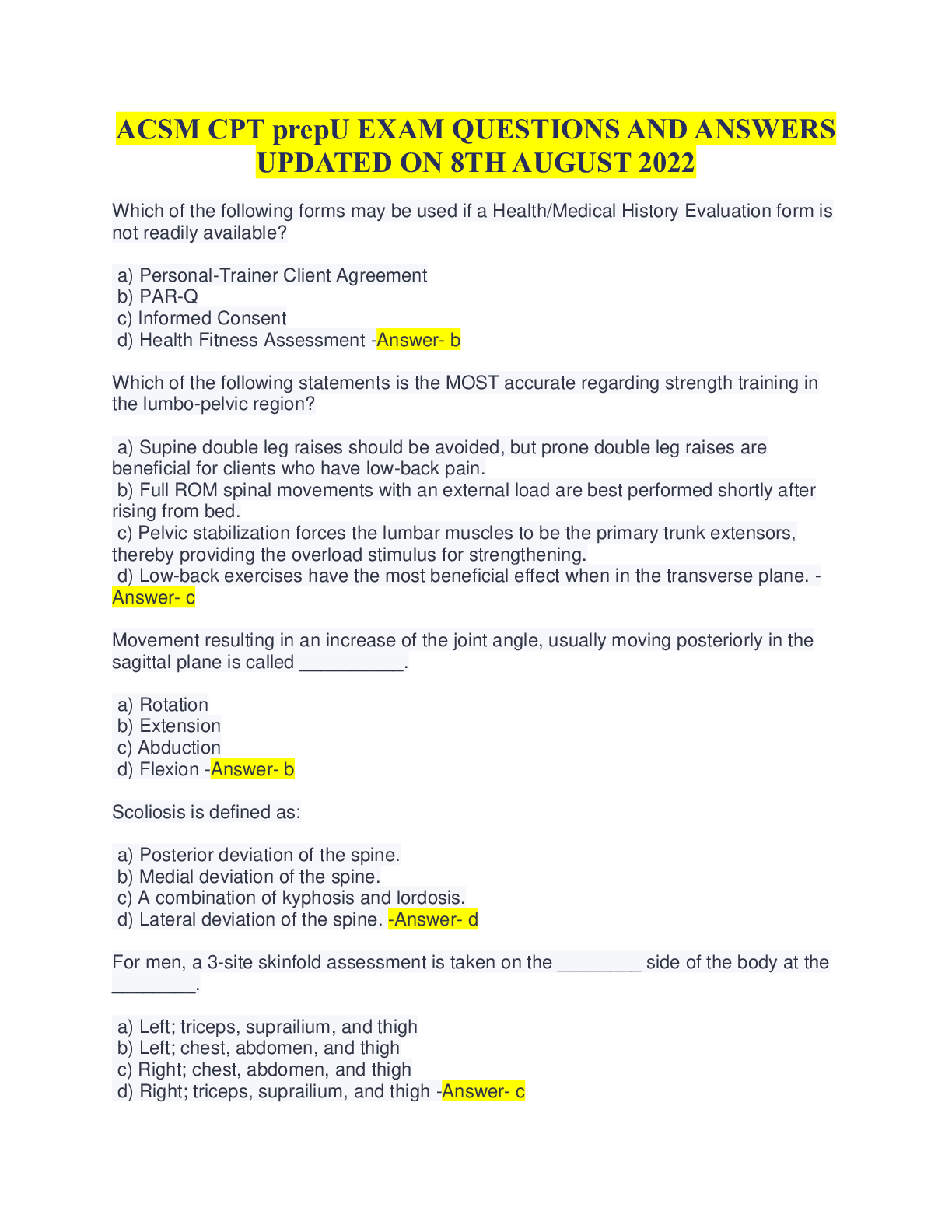
Reviews( 0 )
Document information
Connected school, study & course
About the document
Uploaded On
Jan 09, 2023
Number of pages
165
Written in
Additional information
This document has been written for:
Uploaded
Jan 09, 2023
Downloads
0
Views
391



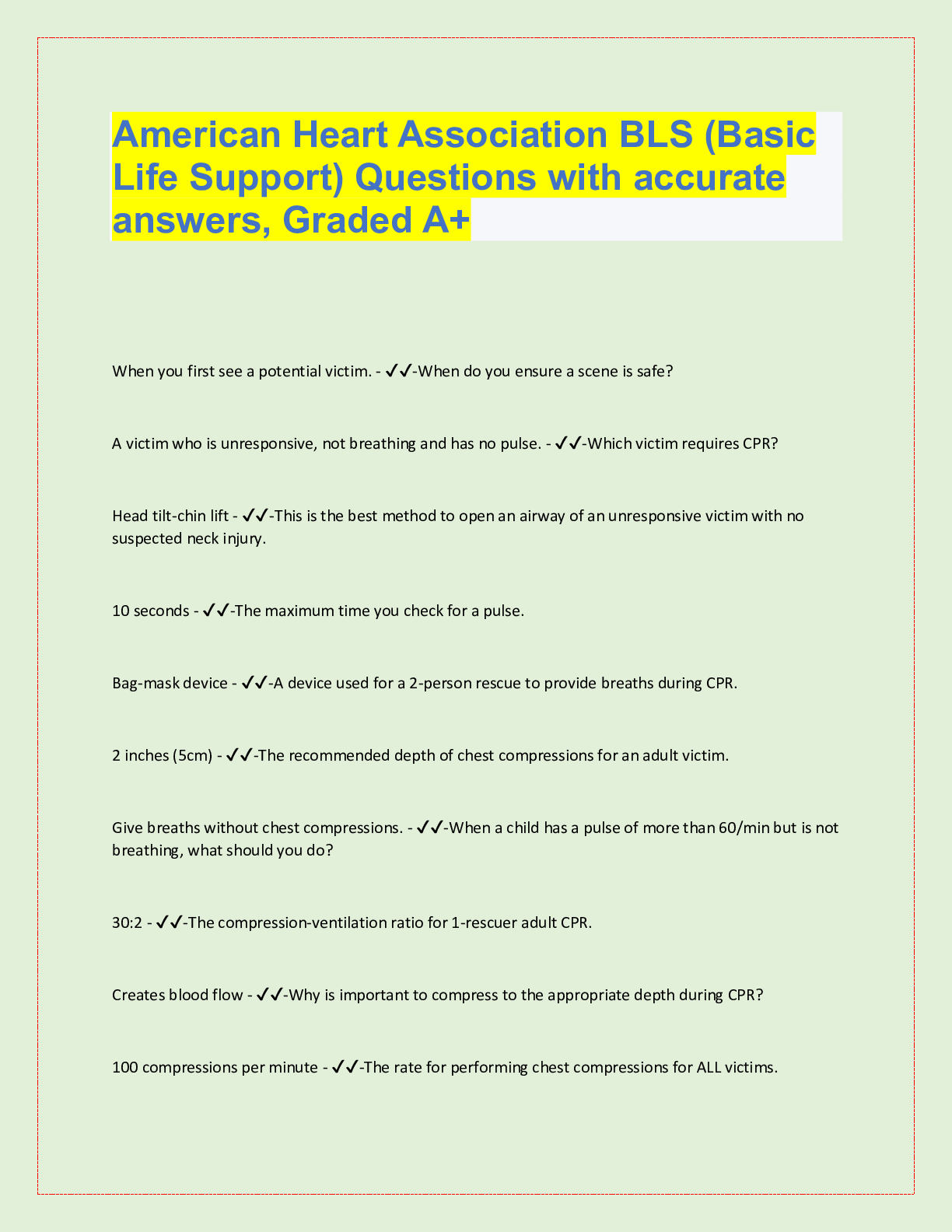


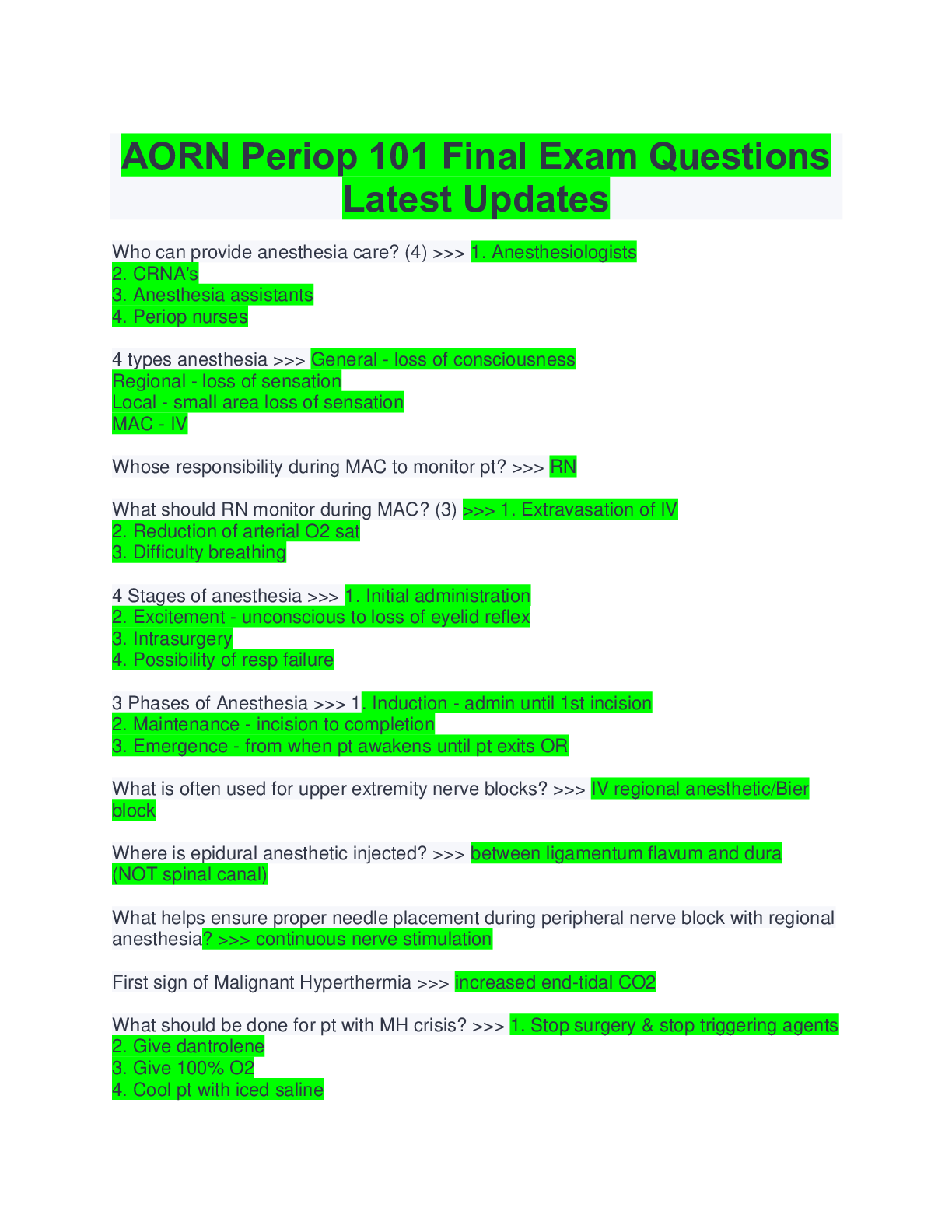






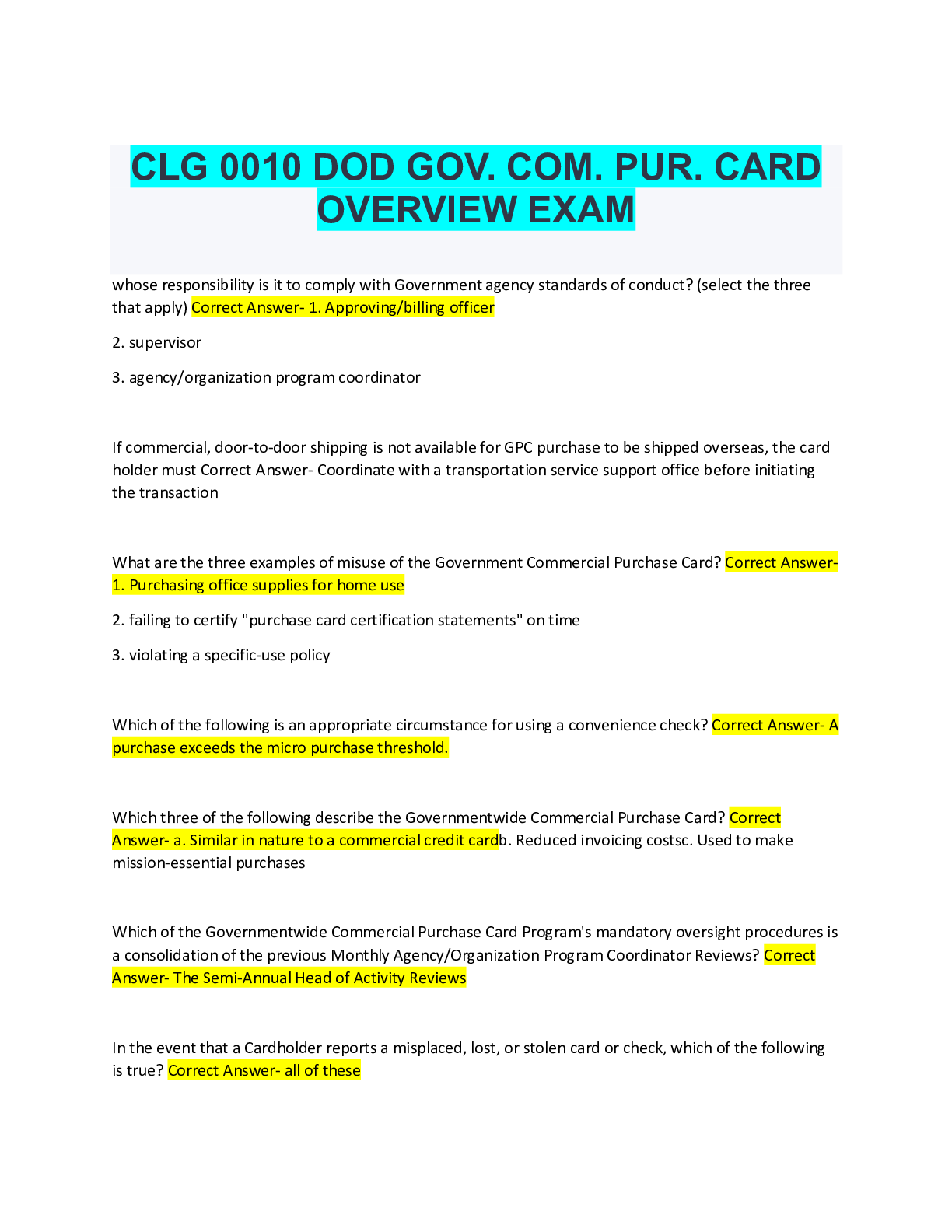


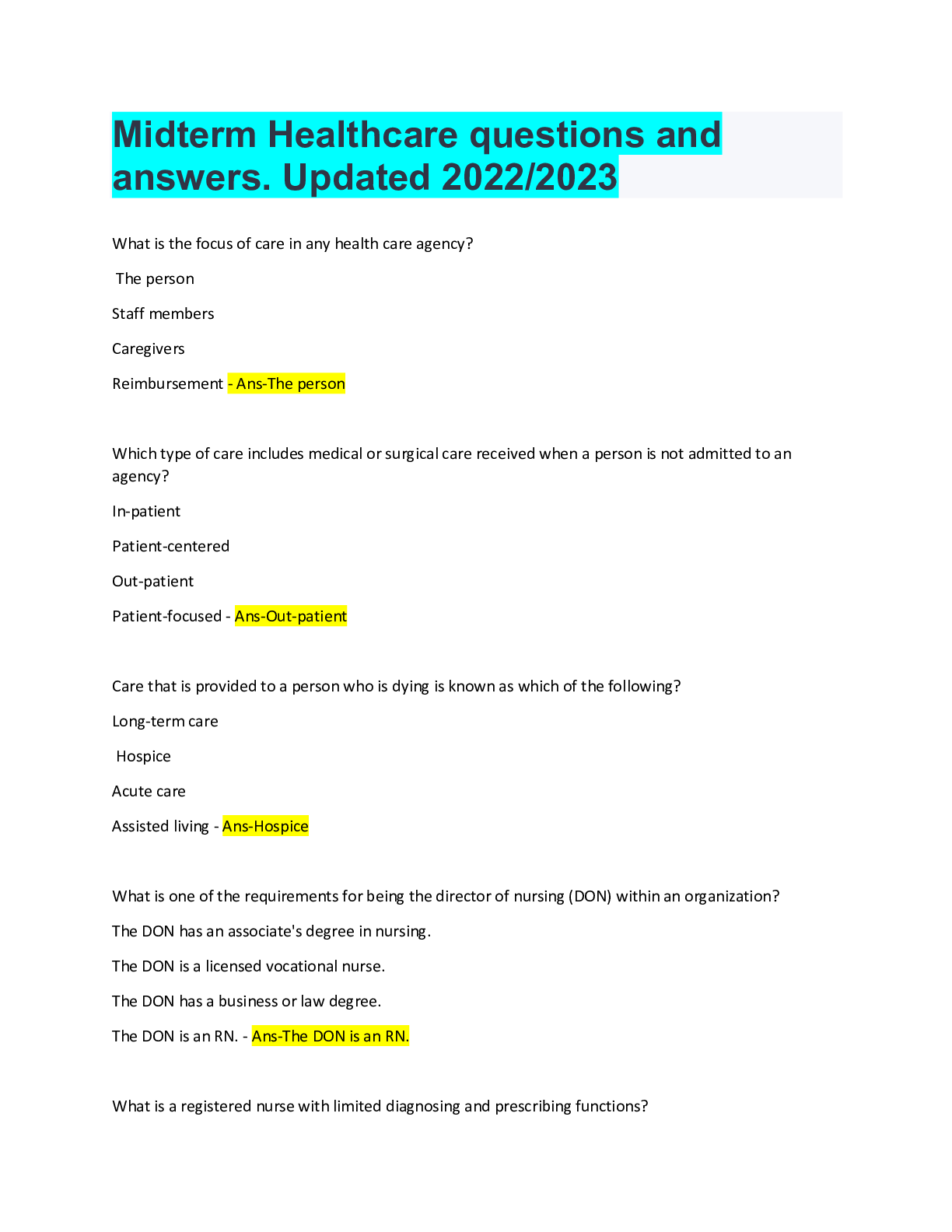
.png)
.png)
